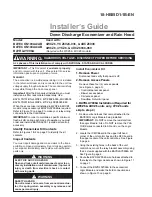
UNT-SVX07E-EN
79
Installation - Electrical
Note:
Any modifications, additions or changes to the
control box could void the factory warranty and UL
certification. Such modification, additions or
changes will become the responsibly of the
modifying contractor.
Unit Wiring Diagrams
Specific unit wiring diagrams, based on unit options
ordered, are provided inside each unit and can be easily
removed for reference. Use these diagrams for
connections or trouble analysis. Wiring diagrams are
attached on the inside of the front panel of vertical cabinet
and recessed models and on the fan and motor panel of
vertical concealed and all horizontal models. For typical
wiring information, see
“Wiring Diagrams,” page 154
.
Note:
Any modifications, additions or changes to the
control box could void the factory warranty and UL
certification. Such modification, additions or
changes will become the responsibly of the
modifying contractor.
Supply Power Wiring
Refer to the unit nameplate to obtain the minimum circuit
ampacity (MCA) and maximum overcurrent protection
(MOP) to properly size field supply wiring and fuses or
circuit breakers.
Refer to the unit operating voltage listed on the unit wiring
schematic, submittal, or nameplate. Reference the wiring
schematic for specific wiring connections.
Note:
All field wiring should conform to NEC and all
applicable state and local code requirements. The
control panel box is always on the end opposite the
piping connections. Access the control box by
removing the two screws that secure the front
cover. This will allow the panel to be removed, to
provide access to the electrical components.
If the unit does not have a disconnect switch, the power
leads and capped ground wire are inside the control panel.
If the unit has a disconnect switch, the power leads are
wired to the disconnect switch on the control panel.
Electrical Grounding Restrictions
All sensor and input circuits are normally at or near ground
(common) potential. When wiring sensors and other input
devices to the Tracer controller, avoid creating ground
loops with grounded conductors external to the unit
control circuit. Ground loops can affect the measurement
accuracy of the controller.
All input/output circuits (except isolated relay contacts and
optically isolated inputs) assume a grounded source,
either a ground wire at the supply transformer to control
panel chassis, or an installer supplied ground.
Interconnection Wiring
The installer must provide interconnection wiring to
connect wall-mounted devices such as a fan mode switch
or zone sensor module.
Refer to the unit wiring schematic for specific wiring
details and point-to-point wiring connections. Dashed
lines indicate field wiring on the unit wiring schematics. All
interconnection wiring must conform to NEC Class 2
wiring requirements and any state and local requirements.
WARNING
Hazardous Voltage w/Capacitors!
Disconnect all electric power, including remote
disconnects and discharge all motor start/run
capacitors before servicing. Follow proper lockout/
tagout procedures to ensure the power cannot be
inadvertently energized. For variable frequency drives
or other energy storing components provided by Trane
or others, refer to the appropriate manufacturer’s
literature for allowable waiting periods for discharge of
capacitors. Verify with an appropriate voltmeter that all
capacitors have discharged. Failure to disconnect
power and discharge capacitors before servicing could
result in death or serious injury.
For additional information regarding the safe discharge of
capacitors, see PROD-SVB06A-EN
NOTICE:
Use Copper Conductors Only!
Unit terminals are not designed to accept other types
of conductors. Failure to use copper conductors may
result in equipment damage.
WARNING
Hazardous Electrical Shorts!
Insulate all power wire from sheet metal ground.
Failure to do so may cause electrical shorts that could
result in death or serious injury.
NOTICE:
Equipment Damage!
Unit transformer IT1 provides power to fan-coil unit
only. Field connections directly to the transformer IT1
may create immediate or premature unit component
failure.
















































